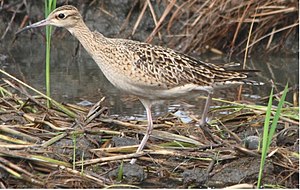Ord River Floodplain
| Designations | |
|---|---|
| Official name | Ord River Floodplain |
| Designated | 7 June 1990 |
| Reference no. | 477[1] |
The Ord River floodplain is the







Description
The site lies about 8 kilometres (5.0 mi) east of the town of Wyndham, extending from 14°51′S 128°12′E / 14.850°S 128.200°E to 15°46′S 128°33′E / 15.767°S 128.550°E. It comprises the Ord River and Parry Lagoons nature reserves, with some additional land. It lies downstream of two large impoundments on the Ord River, Lakes Argyle and Kununurra, which have had a major impact on the river's hydrology through changing its flow pattern so that there are now constant flows through the dry season. In effect, the lower Ord has been transformed through flow regulation at the dams from a ‘dry tropics’ to a ‘wet tropics’ river.[2]
The southern part of the site is dominated by Parry Creek, including 20 kilometres (12 mi) of seasonal creek and an alluvial floodplain which is flooded during the wet season. It dries out quickly in the dry season, except for waterholes associated with incised channels and claypans. The southern, or upstream, part of the floodplain is freshwater, while the northern, or downstream part, is either regularly flooded with saltwater or contains saline soils.[2]
The lower reaches of the Ord River extend from the Parry Creek floodplain northwards to the
Climate
The site has a dry tropical climate. Rainfall is monsoonal, with the hot and humid wet season occurring from November to March. Wyndham has an average annual rainfall of 695 millimetres (27.4 in). The dry season is mild, with periods of steady south-easterly winds. The average maximum temperature varies from 30 °C (86 °F) in July to 39 °C (102 °F) in December.[2]
Flora and fauna
Vegetation
Within the site ten main
The eastern coast of the Cambridge Gulf is one of the richest places for mangroves in the Kimberley region in terms of species diversity, structural complexity, and area, with 14 species occurring within the site. Zonation is evident; mangrove species in the seaward zone form a woodland about 8 metres (26 ft) high, dominated by
Birds
The seasonal wetlands on the floodplain regularly support large numbers of waterbirds. Numerically important duck species include hardhead, grey teal and plumed whistling duck. The lagoons are also an important site for shorebirds: several thousand little curlews and Oriental pratincoles, and hundreds of wood sandpipers have been counted. The Parry Lagoons are probably the most important site in Australia for both wood and marsh sandpipers. When local rainfall is high the lagoons and other seasonal wetlands are major breeding areas for waterbirds in the Kimberley, with up to 77 species recorded in habitats associated with Parry Creek. The grasslands are the only place in Western Australia where zitting cisticolas occur naturally.[2] The mangroves contain 12 of the 13 species of terrestrial bird restricted to such habitat, or to rainforest, in Western Australia, including the black butcherbird. About 200 bird species have been recorded from the site.[2]
Other fauna
The lower Ord River contains a high density of salt water crocodiles. The mangroves support at least six species of
Human activity
The area is a regular tourist destination. Some exploration for alluvial diamonds takes place. The surrounding land is used for cattle grazing.[3]
References
Notes
Sources
- "The Annotated Ramsar List: Australia". The Ramsar Convention on Wetlands. 4 January 2000. Retrieved 13 May 2010.
- "Information Sheet on Ramsar Wetlands: Ord River floodplain". Department of Conservation and Land Management, Western Australia. November 2003. Retrieved 15 May 2010.
- "Issues Paper: Ord River and Parry Lagoons Nature Reserves Draft Management Plan". Department of Environment and Conservation, Western Australia. October 2008. Retrieved 17 May 2010.
